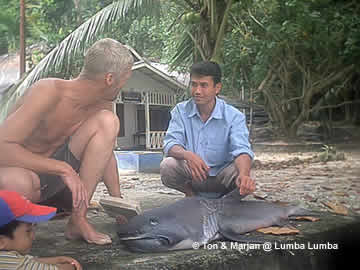
May 29, 2007
Could the solution of the mystery fish photograph on an antique postcard (first noted at Cryptomundo on November 29, 2005) be at hand? Could this postcard reveal evidence of a beached megamouth shark decades before the species was officially verified?
(Click on image to see full size version the Mystery Fish Photo postcard, enhanced by shockbeton)
Mystery Fish head, click to enlarge.

Does the head of the megamouth look similar to that of the Mystery Fish’s head from the old postcard?

The above photograph (and the one below) of this 2004 megamouth are courtesy of Ton & Marjan of the Lumba Lumba Diving Centre, and used with their permission.
The megamouth shark was unknown to established zoology until 1976, when a Naval Undersea Center team from the Hawaii Laboratory made a chance catch. They were working around the Hawaiian Islands, spending a few days aboard a research vessel, and carrying out surveys in the deep waters. Two large parachutes, dropped overboard to a depth of 500 feet, served as sea anchors.
On the day of the team’s departure they hauled in the parachutes, only to discover that they had caught a gigantic shark. It measured 14.5 feet in length and weighed 1,650 pounds.
Leighton R. Taylor, director of the University of Hawaii’s Waikiki Aquarium, recognized it as a heretofore-unsuspected new species.
The media soon dubbed the creature “Megamouth,” due to its extremely large mouth. The mouth of a megamouth is so huge, over four and a half feet wide and extending back behind the shark’s eyes, that a small diver with gear could swim into it. Taylor and his colleagues incorporated the name “Megamouth” in the species’ 1983 scientific description, christening it Megachasma pelagios (“great yawning mouth of the open water”).
Even though the fossil record never even hinted at the existence of such an animal, the discovery of the megamouth caused hardly a ripple in the world of marine science, as Patrick Huyghe and I noted in our 2003 field guide on such matters.
The location for the photo on the postcard shows palm trees, and match where some of the strandings of megamouths have occurred.
Compare the body’s shape and linear patterns of the megamouths with the image of the Mystery Fish on the old postcard shared with me in 2005 by Cryptomundo reader Phyllis Mancz of Ohio.
Postcard, click to enlarge.


Megamouths sometimes show a strange side body hatching, as seen on the Mystery Fish.
Here is a roundup of direct links to the “Mystery Fish Photo” entries in the Cryptomundo.com blog, which were posted in 2005 and 2006:
“Name the Mystery Fish Continued”
Almost four hundred comments, most of them extremely thoughtful and detailed, can be found at the above noted entries, and yours are welcome anew, here, below. Perhaps someone, in passing, mentioned the megamouth before. But in almost 2,500,000 views of the Cryptomundo “Mystery Fish” photo, no one before Steve Bloomfield sent in compelling photos that suggested a match, as he did recently.
Mystery Fish enhancement, click for full-size version, provided by Todd DiLaMuca.
Now, again, compare the head enhancements of the postcard’s Mystery Fish with that of the megamouths found on beaches.
(Click image for full-size version)
(Click image for full-size version, provided by Todd DiLaMuca)

Megamouth, 2004, forwarded by Steven Bloomfield.

Another megamouth.
+++Date of the Postcard++++
The earlier discussions noted the date was between 1904-1918 for this postcard. For example, in this hyperlinked blog (please click), the entire back of the postcard is pictured. Various pieces of research exactly determined that the diagnostic direction of the triangles give forth with a specific range of when these postcards were produced. While the men and the fish could have been photographed before 1904, they could not have been photographed and appeared on this card after 1918.
The window of time for the production of this postcard is, therefore, most probably, between 1890 and 1918. But certainly, this photograph was not taken anytime after 1918, years before the megamouth was even considered as part of the reality of the marine world.
^^^^^^^^^^^^^^^^^^^^^^^^
Thanks again to Steve Bloomfield.
About Loren Coleman
Loren Coleman is one of the world’s leading cryptozoologists, some say “the” leading living cryptozoologist. Certainly, he is acknowledged as the current living American researcher and writer who has most popularized cryptozoology in the late 20th and early 21st centuries.
Starting his fieldwork and investigations in 1960, after traveling and trekking extensively in pursuit of cryptozoological mysteries, Coleman began writing to share his experiences in 1969. An honorary member of Ivan T. Sanderson’s Society for the Investigation of the Unexplained in the 1970s, Coleman has been bestowed with similar honorary memberships of the North Idaho College Cryptozoology Club in 1983, and in subsequent years, that of the British Columbia Scientific Cryptozoology Club, CryptoSafari International, and other international organizations. He was also a Life Member and Benefactor of the International Society of Cryptozoology (now-defunct).
Loren Coleman’s daily blog, as a member of the Cryptomundo Team, served as an ongoing avenue of communication for the ever-growing body of cryptozoo news from 2005 through 2013. He returned as an infrequent contributor beginning Halloween week of 2015.
Coleman is the founder in 2003, and current director of the International Cryptozoology Museum in Portland, Maine.
Filed under Breaking News, Cryptomundo Exclusive, Cryptotourism, CryptoZoo News, Cryptozoologists, Cryptozoology, New Species, Photos, Pop Culture, Year In Review